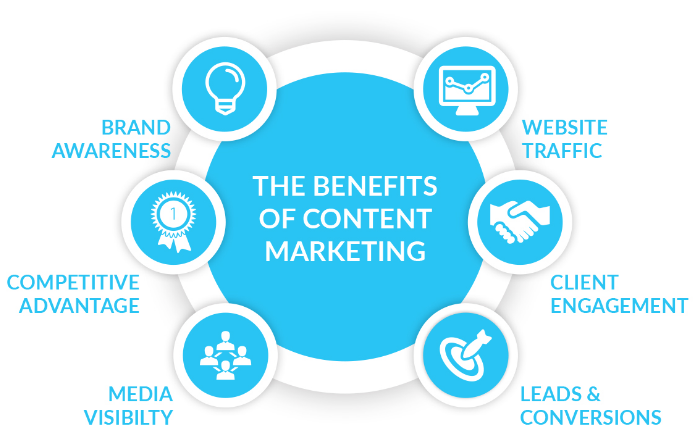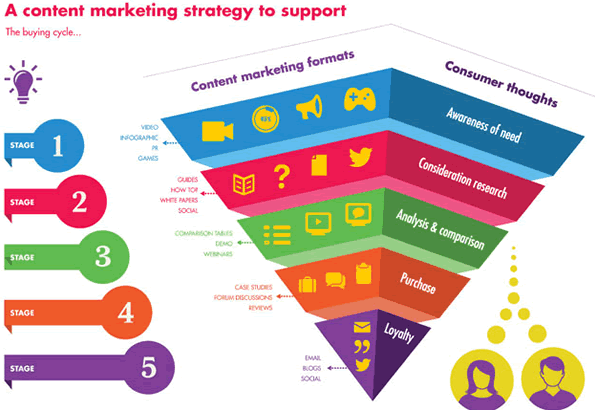Content creation isn’t a taboo anymore. Instead, it is one of the most well-researched approaches towards glory— especially when social media marketing is concerned. If you are looking to connect well with the target audience, the content strategy needs to be perfect. Adjusting the same for perfection also means delivering social media content at consistent intervals.
This is where planning comes to the fore as preempting a content strategy can easily help you reach the envisioned business goals. In the subsequent sections, we will be talking about 7 effective techniques that can help you plan the desired content marketing strategy— synonymous to the social media channels.
-
Understanding Awareness and Conversions
It is important to analyze and even understand the steps taken by customers to finalize the product. Regardless of the time frame of your journey as an entrepreneur, it is always advisable to think like a customer before catering to one. The first few steps should include segregating the customer base— depending upon age, sex and demographics. However, there is a lot more to conversions than what meets the eye.
The company should provide exceptional customer experience while satiating specific user requirements. It is easy to create blog posts and editorials which offer information but it is exceedingly hard to sell something by pitching content.
Usually, there are three steps towards zeroing in on a specific product. Better termed as the sales funnel, this approach is based on logic and also on the human approach. Covering all the three stages of willful customer acquisition includes answering their queries, via webinars, infographics and other forms of content.
It takes time to understand the loyal customer base and then add visitors to the existing list. Create content that brings conversions and not that just offers information.
-
Deciding Social Media Usage
It is important to understand why you are actually using social media channels for. This is instrumental towards drafting the perfect content plan for the business. Goals are of paramount important and in this post, we have the three basic ones enumerated for the readers:
-
Building Community
It is important to draft a specific content marketing plan if growing a community is your primary focus. This requires long-term efforts— including group creation, adding members, offering live videos, overall engagement tracking and answering questions asked within the group. While Facebook doesn’t offer a cohesive tool for addressing analytics, using a third-party resource can come in handy.
-
Increasing Brand Awareness
Most companies use social media for growing brand awareness and this can actually be platform specific in most cases. If your desired platform is Twitter, it is advisable to look at the follower count, impressions, new followers, profile visits and even mentions. Once the Twitter analytics are viewed, content planning can then be started— according to the situational requirements.
-
Boosting Engagement
Many business take to social media for boosting overall levels of engagement. This in turn helps with better perceptions, building trust and even notable recommendations. Engagement is of paramount important when businesses are handling Instagram and Facebook accounts. This is where an effective content marketing strategy fits in.
-
Choosing the Right Platform
This point is more of an extension to the previously mentioned hacks. Every customer might not resonate with specific social media platforms and companies need to take the same in the stride— even if it comes with a grain of salt. There are many users or customers who prefer vibrancy over anything else and text based platforms or business might just minimize their engagement levels.
The idea here is to focus on the reciprocity across multiple platforms and even the demographics.
-
Facebook
This happens to be the most widespread social media platform which offers a wide range of possibilities to the businesses— depending upon demographics and age. Not just the reach, Facebook also brings forth an expansive palette of new features for you to interact better with the customers. Some of the most striking ones include a wide-selection of emojis, post reactions and the live video functionality.
Facebook has recently allowed the inclusion of emoji keyboard and input options pertaining to other languages. Language specific keyboards or emoticon keyboards can be downloaded from the app stores of certain operating platforms and used according to requirements. More often than not, these virtual keyboards come in handy while drafting a certain kind of content plan for Facebook.
-
Twitter
This social platform has a great portion of active users and according to Statista— the age groups on display are pretty expansive. Be it the proper use of emojis or inclusion of virtual keyboards while customizing the tweets— twitter offers an extensive base for drafting the near-perfect content plan.
-
Instagram
Here is a social platform that is expected to top many charts in the long run. The concept of instagram stories is something revolutionary and allows one to make great connections with the loyal follower base. In addition to all that, instagram stories can be further decorated using an expansive list of emojis.
-
Pinterest
While the demographics are not as well balanced as on Facebook, Pinterest still boasts of better female engagement as compared to their male counterparts.
-
LinkedIn
The network leader in B2B marketing— LinkedIn boasts of enviable coverage and massive examples of effective content curation. This is one multi-lingual channel that expands beyond 200 countries and offers the best possible content platform for the longer-forms.
-
YouTube
World’s second when it comes to search engine traffic, YouTube boasts of a massive user base and urges businesses to create a specific form of content plan for winning big over the same.
-
Snapchat
Still in its formative years, Snapchat already has a monthly user base of 301 million. This platform usually caters to the millennials and banks on emojis for connecting well with the audience. Emojis or even emoticons are embedded within the algorithm of this platform— hinting towards the growing popularity of a specific content marketing plan.
-
Researching Topics
Now when you have already decided which social media platform to concentrate on— planning the topic for your content becomes important. The focus should be on creating unique, relevant and specific posts which describe the business and the associated goals.
To find out customer inclinations, look to conduct a poll of sorts— over the preferred social platform. This kind of poll allows businesses to find which content would resonate with whom. The poll should be in the form of a questionnaire and can also be created using the functional Google Forms.
In addition to that, keep tracking the competitors for understanding what works and what not.
-
Planning the Content Calendar
The next step comprises of drafting the much-anticipated content calendar. However, it is always important to get the first blog post out of the way. Once concluded, you need to look for specific industry-centric topics for keeping up with customer requirements.
The blog articles need to be refined for three types of keywords— namely navigational, transactional and informational. This, in turn, actually covers the economic, informative and even brand-centric aspects of the sale. Following this approach assists content marketers with the specifics of the blog— which can then be divided into four segments— including introduction, body, conclusion and even call to action.
Once the blogging roadmap for a few weeks has been drafted, it is necessary to curate and publish the same on social media. In addition to general content— it is also advisable to include the likes of video, live video, screencasts or even a photo montage. The likes of hybrid video and animated stuffs can also be pitched in.
-
Building Trust
One aspect of creating lasting content is to keep the customers engaged over social media. Two-way conversations are great tool for the same as the audience will then feel at ease with the brand and business. If statistics are to be believed, every successful sale needs at least eight touches to get going and social media can easily shorten this process.
-
Measuring the Process and Adjusting the Course
This happens to be the last process which can fix any shortcomings synonymous to your content plan. By this point, you must have already followed the 6 ideas and it will be advisable to cross check each in terms of output and efficacy.
-
Conversions
While we have already talked about the role of emojis when it comes to engaging the customers, it is important to contemplate the conversion rates associated with each engagement. Look for the number of sales via Google analytics and tweak the existing plan— if needed.
-
Reach
This aspect actually involves the social media popularity courtesy some of the metrics like twitter followers, LinkedIn connections, instagram followers, website visitors and what not.
-
Engagement
Lastly, it is important to gauge the engagement levels associated with a business. The associated metrics include social media clicks, mentions and retweets, social media shares and even comments.
The Wrap
Content strategy for social media marketing is entirely different from the existing ones— drafted for blogs and web pages. It is therefore, advisable to have a concrete plan for making the business thrive.

